There’s nothing quite like watching your little one ride away on their first pedal bike! But choosing the wrong bike can quickly turn the experience sour – most small pedal bikes are notoriously heavy and difficult to ride.
Luckily, we’re here to help! Over the last decade, we’ve tested more than thirty 12 and 14 inch bikes with a flock of our kids and friends. From confident, 3-year-old balance bike graduates to timid 4-year-olds who prefer to use training wheels, we’ve seen it all and have a bike recommendation to match.
Some of the prices of bikes may give you sticker shock, but we promise you they are significantly easier to ride than bikes found at big-box stores. They also have much higher resale values for when your preschooler outgrows them.
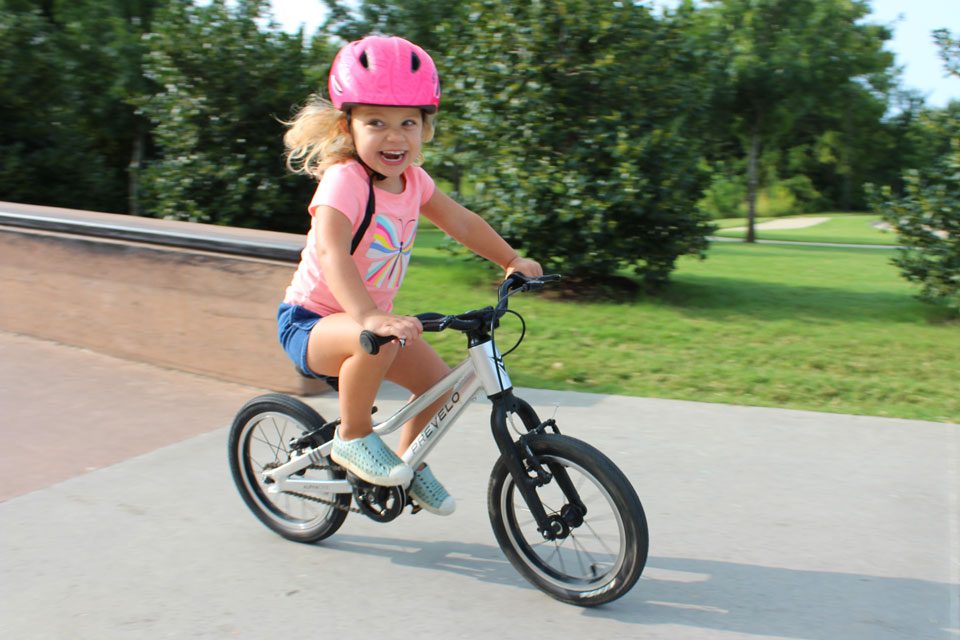
The Best 12 and 14 Inch Bikes Rundown
| Bike | Why We Love It | Price |
|
Best for Use Without Training Wheels |
||
| Guardian Bikes 14 | Innovative SureStop Brakes | $249 |
| woom 2 | Most Lightweight | $399 |
| Prevelo Alpha One | Best for the Shortest Riders | $399 |
| Pello Romper 14 | Best for Taller Riders | $369 |
| Cleary Gecko | Best for Tiny Aggressive Riders | $350 |
| Strider 14x | Balance Bike with optional Pedal Kit | $209 |
|
Best For Use with Training Wheels |
||
| Guardian Bikes 14 | SureStop Brakes + Training Wheels Kit | $289 |
| Trek Precaliber 12 | Tool-free Training Wheels | $279 |
| Retrospec Koda 12 | Good design on a budget | $99 |
| Bikes We Don't Recommend | ||
| RoyalBaby Freestyle | Poor geometry and performance | $149 |
| REI Co-op REV 12 | Difficult to ride for the price | $219 |
Want to see our recommended bikes in action? See our littlest bike testers pedal their hearts out in our Best 12 and 14 inch bikes video below!
Bike Buying Tips for 3-year-olds
- 12 and 14 inch bikes are pretty small and typically fit most 3 year olds. If your child is older than 3, they are most likely a better fit on a 16 inch bike.
- Balance bikes teach kids how to balance a bike MUCH faster and easier than a bike with training wheels and they are usually cheaper. Consider getting a balance bike (See our Best Balance Bikes page.) BEFORE you buy a bike with training wheels.
- Higher-end bikes are lighter, smaller, better quality, and are generally much easier to ride than low-end bikes. We also strive to find bikes at all price points. Every bike on this list has been personally tested and approved by our team of kid bike testers.
- The seat height of the bike is the best way to determine a proper fit.
- For new pedal bike riders: a child’s inseam should match the seat height of the bike. This ensures they can stop the bike with their feet flat on the ground.
- For experienced pedal bike riders and for kids using training wheels: a child’s inseam should be about 2 inches LESS than the bike’s seat height. This allows for proper leg extension when pedaling. Kids will need to rely on the bike’s brakes (pedal brake or handbrake) to stop.
Mini Reviews of Our Top 12 and 14 Inch Bikes
Guardian Bikes 14
Best Safety Innovation – SureStop Brakes
• MSRP: $249
• FITS KIDS: With inseams ranging from 16″ – 20″
• WEIGHT: 16 lbs.
• TRAINING WHEELS: Compatible, purchased as an add-on
• TIRE SIZE: 14″
• HIGHLIGHTS: SureStop braking system, kid-friendly geometry, easy to balance, no coaster brake
• FULL REVIEW: Guardian Bikes 14″
While there are a ton of things to love about Guardian Bikes, the proprietary SureStop braking system really makes them unique. SureStop brakes have a single brake lever on the right hand that activates both the rear and front brake.
With just one brake lever, you get all the stopping power you need! And as the cherry on top, the Guardian 14 does not have a coaster (back pedal) brake, which is a big benefit for little ones first learning to pedal.
SureStop not only makes braking faster, but also helps kids internalize proper braking technique from the get-go. As kids get older and ride much faster, braking with the front brake only (usually found on the left hand) can cause them to endo (flip over the handlebars). SureStop trains kids to rely on their right hand for braking.
PROS:
- SureStop braking system for faster and safer braking
- Only one brake lever required to engage front and rear brakes – easier to manage for young riders
- Child-friendly bike geometry places child in natural and comfortable upright position
- No coaster brake! (Back pedal brakes can make it harder to learn to ride a bike)
- 6 fun color combinations
- Incredible quality for the price
CONS:
- A bit heavier than other (more expensive) bikes on this list
- Very short crank arms make bike less suitable for really aggressive or fast riders
woom 2
Best 14 Inch Overall and Most Lightweight
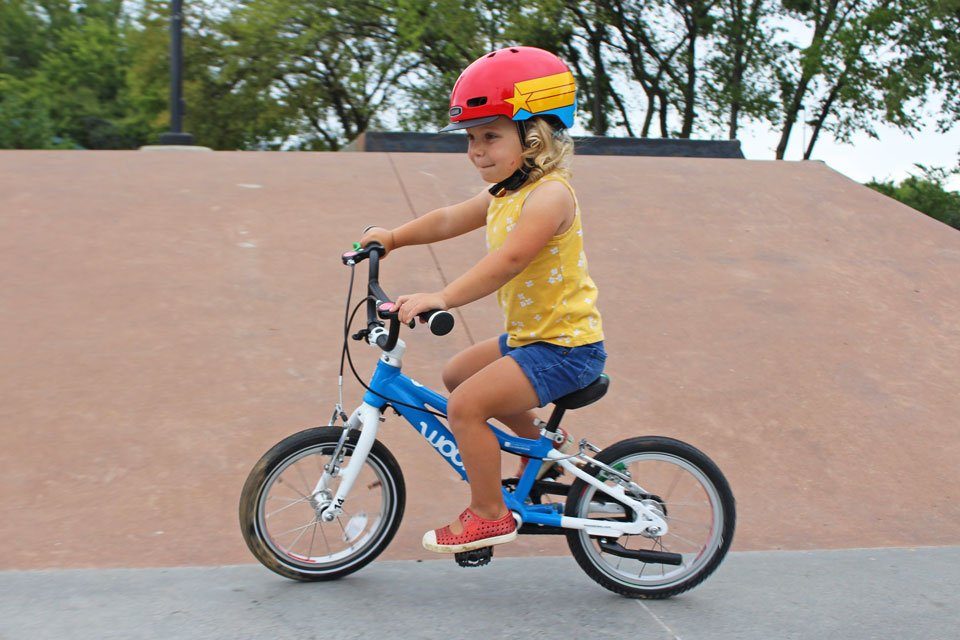
• MSRP: $399
• FITS KIDS: With inseams ranging from 16″ to 19″
• WEIGHT: 12.3 lb.
• TRAINING WHEELS: Not compatible
• WHEEL SIZE: 14 inch
• HIGHLIGHTS: Super lightweight, dual hand brakes, no coaster brake, every detail fine-tuned to fit the smallest riders
• FULL REVIEW: woom 2
Easy and intuitive, the woom 2 is the perfect first pedal bike for balance bike graduates. At just over 12 pounds, it’s the LIGHTEST 12 or 14 inch bike on the market, which has a HUGE effect on a child’s ability to manage a bike. It also has a smart combination of top-end components, bike geometry, and brake design that work in unison to create a natural, fun, riding environment.
The woom 2’s unique geometry centers the child’s weight over their hips (just like when standing), and keeps a child in a comfortable, upright position. This allows the bike and the child’s body to work together in a natural and easy process.
PROS:
- Natura,l upright body position and easy to balance
- The lightest pedal bike on the market (just 12.3 lb.)
- High-end components
- Green right-hand lever to promote safe braking
- Optional freewheel kit (gets rid of coaster brake)
- Available in five colors
CONS:
- You’ll need to purchase a $20 freewheel kit to remove the coaster brake
Prevelo Alpha One
Best 14 Inch for Short Riders
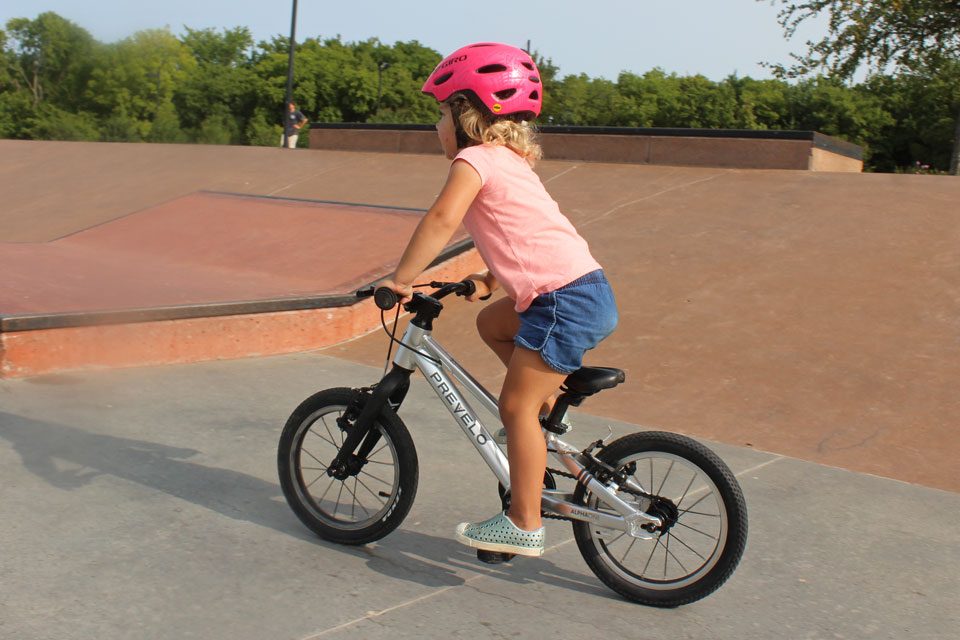
• MSRP: $399
• FITS KIDS: With inseams ranging from 14.8″ to 19.3″
• WEIGHT: 13.3 lb. with freewheel kit installed
• TRAINING WHEELS: Not compatible
• WHEEL SIZE: 14 inch
• HIGHLIGHTS: Lightweight and nimble, MTB-styling
• FULL REVIEW: Prevelo Alpha One
The Prevelo Alpha One is one impressive and tiny bike for the smallest and most eager balance bike graduates. With high-end components, sophisticated, yet kid-specific design, and durability to last through several kids, you’ll be wishing you were small enough to ride it.
With lower-set handlebars than most other bikes on this list, the Alpha Zero is a solid choice for aggressive balance bike riders ready to tackle pedals. The lower handlebars allow for more of the child’s weight to be over the handlebars, which helps the aggressive rider to better maneuver and control the bike.
And with the lowest seat height of any 12″ or 14″ bike on the market in the US, the Alpha One is a much needed solution for parents with tiny groms who are ready to tackle the world of two wheels and pedals… and just can’t wait for a bigger bike!
PROS:
- Lowest seat height of any 12″ or 14″ bike, so very small riders can start pedaling earlier
- Lower rise handlebars make shifting weight around a breeze for adventurous riders
- Responsive, easy-pull, dual-hand brakes
- Low center-of-gravity for better balance
- Top quality components
- Lightweight, low step-through frame
CONS:
- Freewheel purchase required to remove coaster brake
Cleary Gecko
Best 12 Inch Bike for Tiny, Aggressive Riders
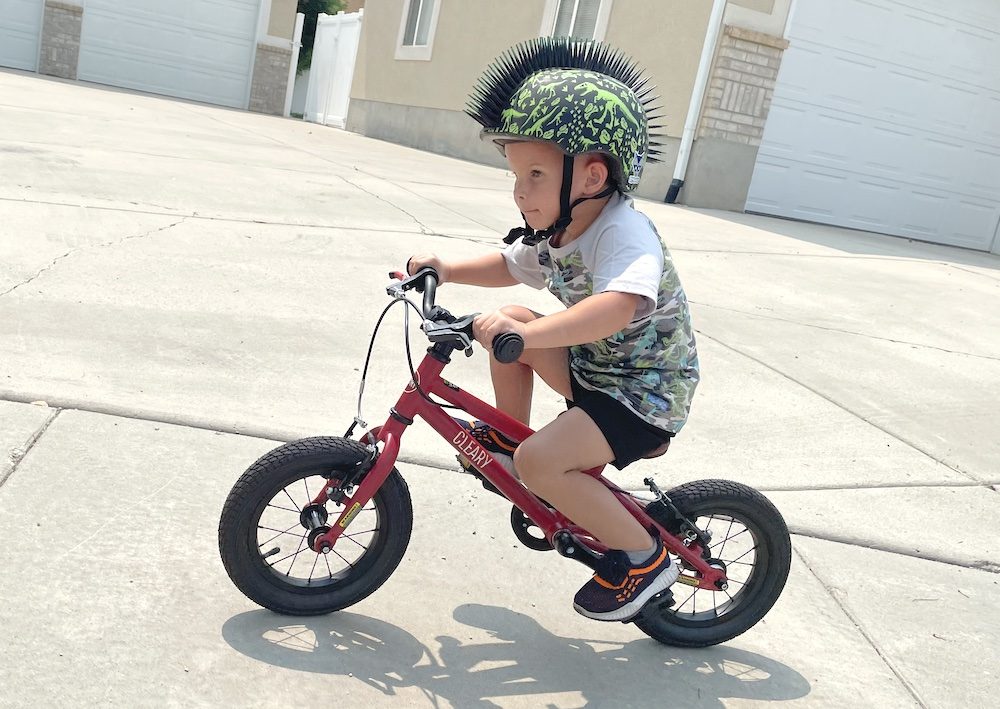
• PRICE: $265+
• FITS KIDS: With inseams ranging from 15″ to 19″. Best for balance bikes graduates still in size 3T/4T clothes.
• WEIGHT: 13 lb.
• TRAINING WHEELS: Not compatible
• WHEEL SIZE: 12 inch
• FULL REVIEW: Cleary Gecko
The smallest bikes on our list, the Cleary Gecko is a good option for some smaller riders. While an excellent quality build, the Gecko’s geometry can be quite challenging for many riders as it puts the rider in a really stretched out position that most kids don’t prefer.
On the other hand, we’ve had a few confident and aggressive test riders who prefer the Gecko over every other bike we offered them! As a result, we only recommend the Gecko for the smallest of riders who have no hesitancy about getting started. If your child is hesitant or not ready, we recommend the Prevelo Alpha One instead.
Available with or without a coaster brake (back pedal brake), both models come with dual-hand brakes. As an added bonus, the rear wheel cog can be swapped out for different gearing options.
PROS:
- Very low minimum seat height accommodates little riders
- Easy-reach, easy-pull dual-hand brakes
- Optional rear cogs allow for different gearing options
CONS:
- Stretched out geometry makes for a very aggressive body position
Pello Romper 14
Best for Taller Riders
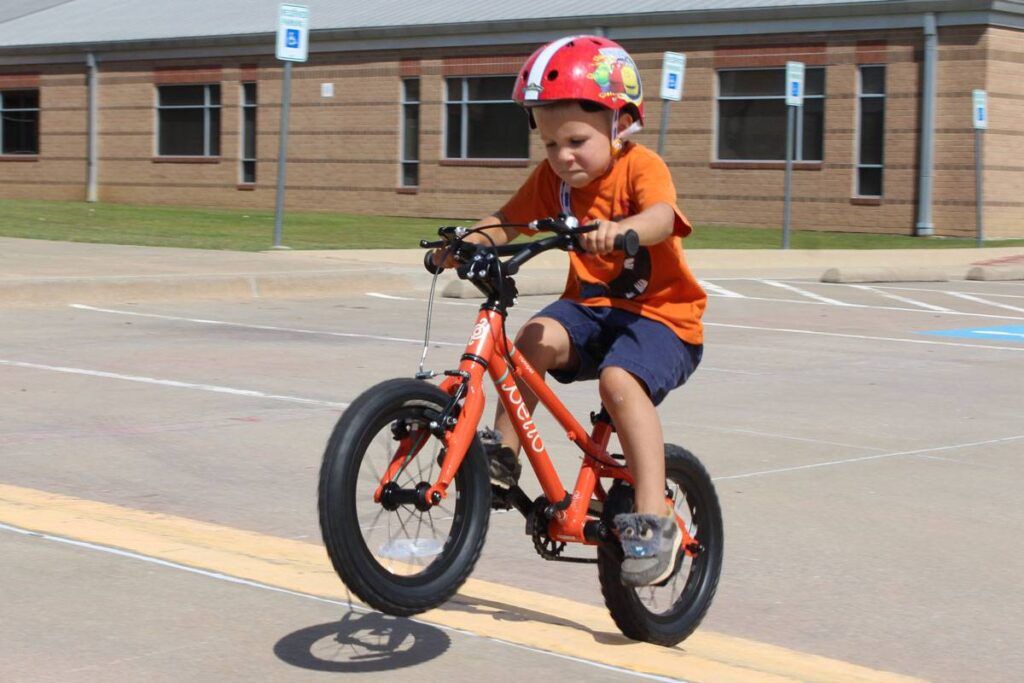
• MSRP: $369
• FITS KIDS: With inseams ranging from 17.25″ – 21.25″
• WEIGHT: 15.9 lb.
• TRAINING WHEELS: Compatible but not provided
• WHEEL SIZE: 14 inch
• FULL REVIEW: Pello Romper
From Kenda tires and Tektro brakes to Cane Creek headsets and lightweight aluminum frames, Pello Bikes ooze quality while excelling on paved bike trails and single-track dirt trails. On paved rides, little ones can happily keep up with the older kids in the pack, while on single-track, the knobby tires provide much-needed grip for rocky trails.
With a minimum seat height about 1.5 – 2” taller than our other favorite bikes on this list, the Pello Romper will be a better fit for kids transitioning to a pedal bike around 3 or 3.5 years old. While there are some 16″ bikes with saddles as low as the Romper, less-confident kids are better off learning to pedal on a 14″ bike which is less cumbersome for them to maneuver.
PROS:
- Thick and knobby Kenda air tires are perfect for all-terrain riding
- For ultimate responsiveness in steering, built with a sealed cartridge bearing Cane Creek headset
- Larger frame and higher handlebars allow for more room for growth for taller or larger-framed kids
- Coaster brake can be removed with Pello’s $20 freewheel kit
CONS:
- Bigger tires add weight – may be an issue for some riders
Strider 14x
Best Balance Bike/Pedal Bike in One
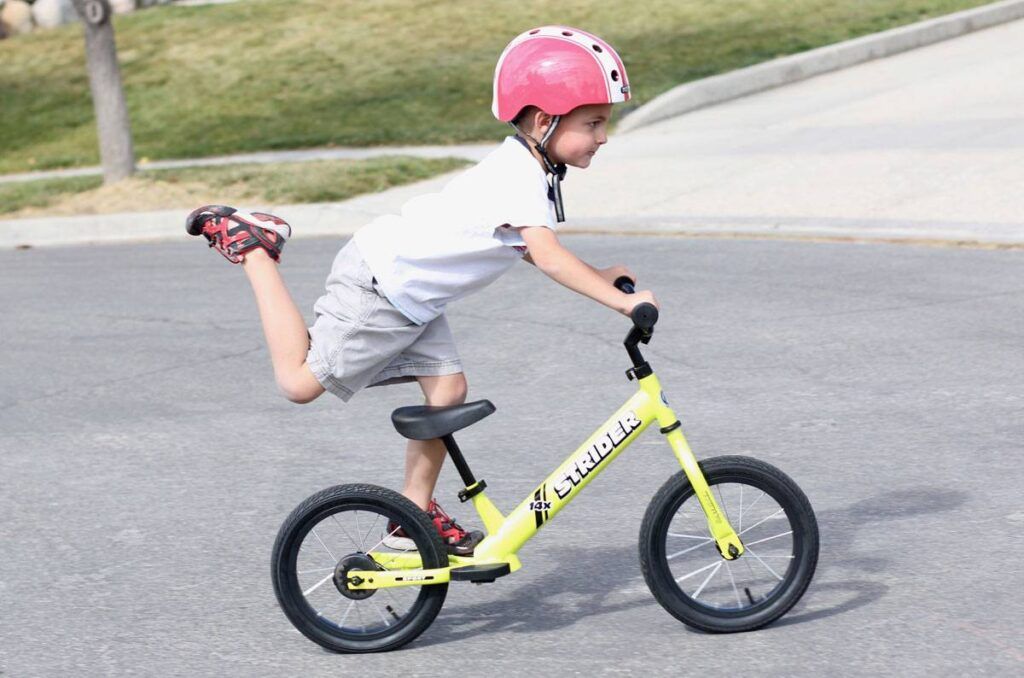
• MSRP: $219
• FITS KIDS: While the manufacturer recommends from ages 3 to 7, based on our testing, we recommend only from ages 3 to 5, or with inseams ranging from 15″ to 20″ in balance bike mode and 14″ to 20″ in pedal bike mode.
• WEIGHT: 12.5 lb.
• TRAINING WHEELS: Not needed! Balance bike converts to a pedal bike
• WHEEL SIZE: 14 inch
• FULL REVIEW: Strider 14x Convertible Balance Bike
A great option for preschoolers who have yet to master a balance bike, the Strider 14x is a balance bike that converts to a 14 inch pedal bike. No need for training wheels – once a child has learned to balance while in balance bike mode, simply put on the optional pedal kit and within a couple of minutes they’ll be pedaling away! Once your child outgrows the pedal bike mode, they will be ready for a 16″ bike.
Due to taller handlebars, the Strider is best for taller 3-year-olds and up. The longer reach between the seat and the handlebars is a bit too much for preschoolers, who are much better off on the standard Strider 12″ Sport. Based on our experience, the Strider is ideal for kids in size 5 clothes or less.
For other convertible balance bikes, check out our Balance Bikes with Pedals list.
PROS:
- Starts as a balance bike and easily converts to a pedal bike
- Larger frame and wheel size fit kids from ages 3 to 5
- Comfortable, upright body positioning promotes confidence for beginners
- Cushioned, ergonomic seat
CONS:
- No hand brake – coaster brake in pedal mode
- Very short crank arms in pedal mode – difficult for kids over age 5 to ride
Trek Precaliber
Best 12 Inch Bike with Tool-FreeTraining Wheels
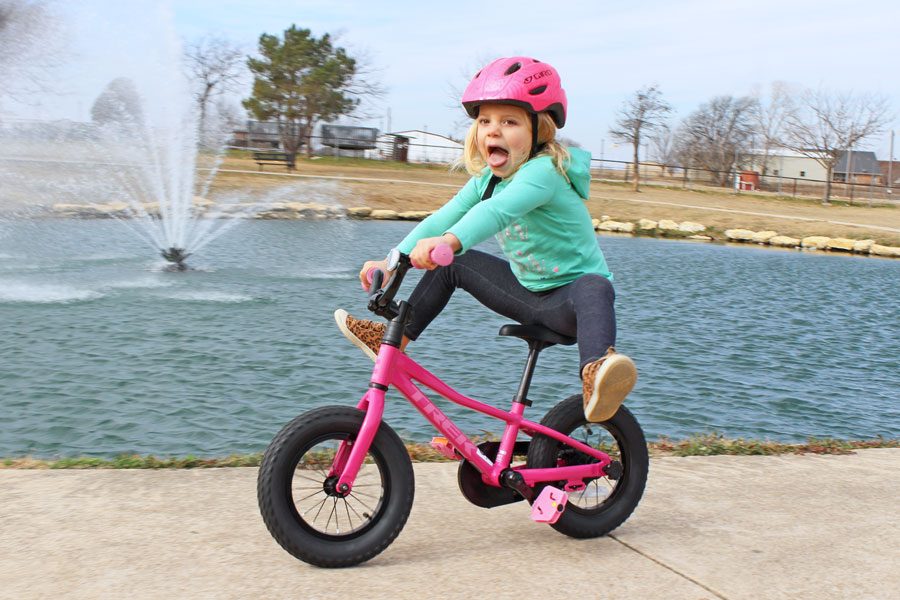
• MSRP: $279
• FITS KIDS: With inseams ranging from 15″ to 17.5″.
• WEIGHT: 14.3 lb. (without training wheels)
• TRAINING WHEELS: Comes with training wheels, which attach via a knob – no tools required!
• WHEEL SIZE: 12 inch
• FULL REVIEW: Trek Precaliber 12
Our favorite 12″ bike found online or in local bike shops, the Trek Precaliber boasts similar geometry to the high-end bikes on this list. It also has one of the lowest minimum seat heights, which makes it a great choice for kids transitioning to a pedal bike early.
While other bikes seem like “clown bikes” as kids get taller and older, our 40.5″ tall three-year-old rode the Precaliber 12 at its maximum seat height and still looked comfortable and natural.
With solid and durable components and wider tires for increased stability, the Precaliber 12 is a great quality bike for the price. The Precaliber’s coaster brake and lack of hand brakes is reflected in its lower price tag.
PROS:
- Kid-friendly geometry offers plenty of space for growth and easy maneuvering
- Very lightweight for its price point
- Available in local bike shops
- High-quality training wheels (if you need them)
- Wide 2.3″ tires increase stability
CONS:
- Coaster brake and no hand brake
Retrospec Koda 12
Super Bang for your Buck – for use with training wheels only
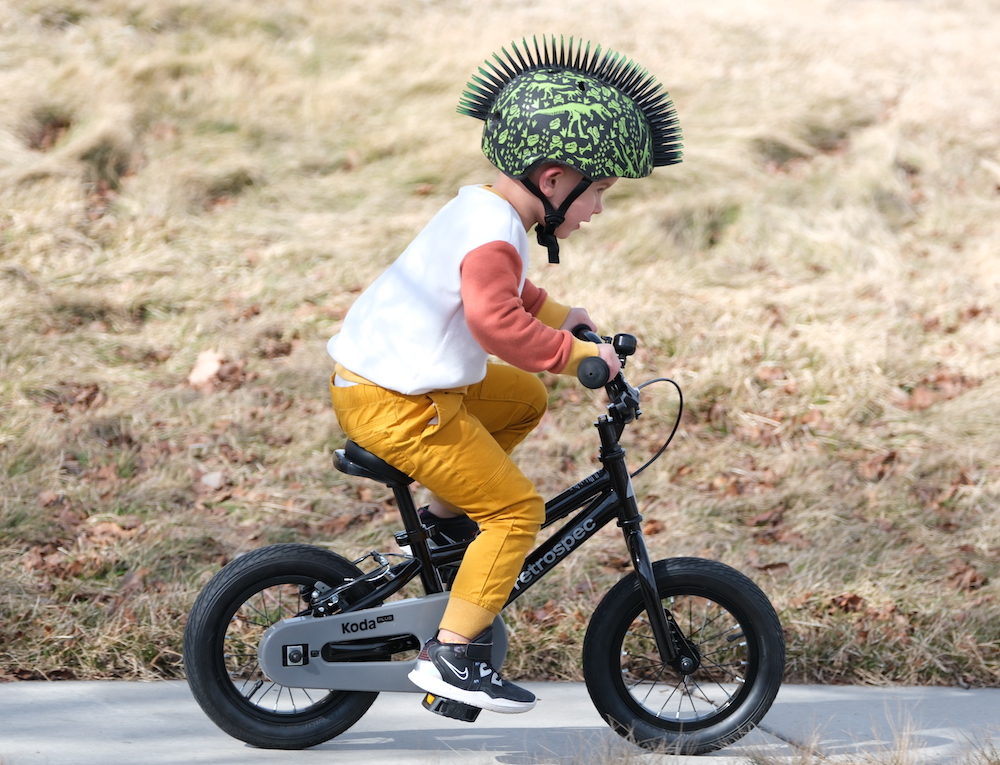
• MSRP: $99
• FITS KIDS: With inseams ranging from 15″ to 18″.
• WEIGHT: 17 lbs.
• WHEEL SIZE: 12 inch
• TRAINING WHEELS: Included
• FULL REVIEW: Retrospec Koda 2
If you’re on a tight budget and you plan on having your little one use training wheels, the Retrospec Koda 2 is a great bang for your buck. This 12 inch bike offers significantly better geometry than similarly priced-bikes, and is also more lightweight and better quality.
While the Retrospec can certainly be ridden without training wheels (as shown above), it isn’t ideal. Like the REI 12″ below, the crank arms are really short which makes it hard for kids to pedal quickly (their feet easily fly off the pedals).
Since kids can’t pedal as fast on a bike when it has training wheels, not only will their feet not fly off the pedals as much, but pedaling backwards to engage the coaster brake is easier, despite the short crank arms. As a result, the Koda 12 bike is suitable for use with training wheels only.
The Retrospec Koda 2 Plus has a handbrake in addition to the coaster brake, but it is hard to engage and only helps to slow the bike down, not stop it completely. Kids will need to use the coaster brake in addition to the hand brake to stop on the Plus model.
PROS:
- Great geometry for a budget bike – MUCH better than on big-box store bikes
- Impressive quality for the price
- Easy-to-use training wheels
CONS:
- Hand brake (on Plus model only) can be hard to pull for small riders, but bike does have a coaster brake
12 Inch Bikes we DON’T RECOMMEND
Don’t purchase a bike based on Amazon’s best-seller lists or their reviews! If there was a cheap bike on Amazon that was better than any of the bikes we recommend, we would absolutely recommend it – but there isn’t (and was constantly check).
RoyalBaby Freestyle
Too Tall and Cramped to Ride

• MSRP: $150
• FITS KIDS: With inseams ranging from 15″ to 17.5″.
• WEIGHT: 21.7 lb. (14″, with training wheels)
• TRAINING WHEELS: Comes with training wheels
• WHEEL SIZE: 12 inch or 14 inch
• FULL REVIEW: Royalbaby Freestyle
Besides being very heavy, the biggest problem with the RoyalBaby Freestyle 14-inch and 12-inch bikes is the bike’s poor frame design and seat height combination. The frame’s size and the room in the cockpit (distance between the saddle and the handlebars) are appropriate for a child on the smallest end of their sizing range, but the minimum seat height is too tall for those kids to safely ride it.
A child that looks like a good fit on the RoyalBaby Freestyle can barely touch the ground with their toes, or even not at all! Once a child is tall enough to comfortably touch the ground to help themselves safely stop, they are too tall in comparison to the size of the bike’s frame. This leads to a cramped and awkward ride.
Additionally, our test riders found the Freestyle pretty difficult to get started pedaling.
REI Co-op Cycles REV 12
Training Wheels Have Faulty Design
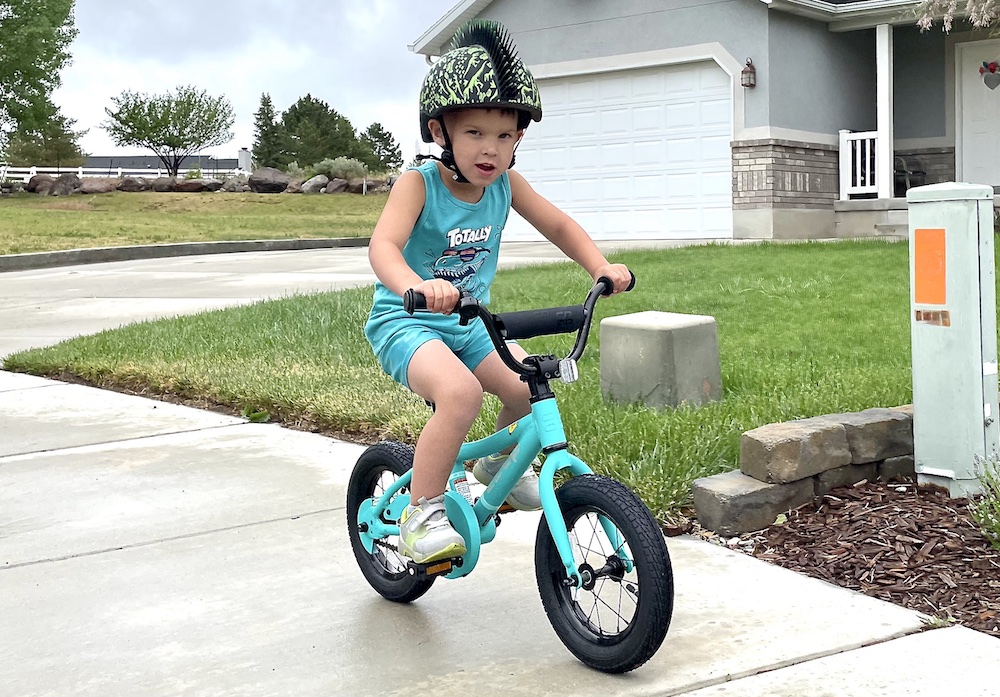
• MSRP: $219
• WEIGHT: 15.8 lb. (without training wheels)
• TRAINING WHEELS: Comes with training wheels, but the tightening mechanism can get stripped, leading to the training wheels coming loose and falling off
• TIRE SIZE: 12 inch
• FULL REVIEW: REI Co-op Cycles REV 12
REI’s Co-Op Cycles are popular for their good quality, fair prices, and REI guarantee, but unfortunately, we cannot recommend their Co-op Cycles REV 12. Due to its short crank arms, our testers found the REV 12 challenging to pedal as their feet often flew off the pedals.
The small crank arms also made it challenging to activate the coaster brake (back pedal brake). While training wheels help negate some of these issues because kids can’t ride as fast, this is where the REV has an even bigger problem. The REV’s training wheels are poor quality and have fallen off for some users (see REI reviews).
The REV also does not have the option of a handbrake like the Retrospec Koda Plus model.
How to Choose the Best Bike for 3-Year-Olds
As parents ourselves, we know it’s hard to resist purchasing the first cute bike you see for your little rider! Whether it’s princess or superhero-themed, the anticipation of seeing your little one’s eyes light up upon seeing the bike is SO tempting. But after years of experience, we can assure you that those cute bikes at the big-box store, quickly lead to frustration and tears.
Those cute (and often cheap) bikes are designed to primarily look super cute. They are NOT designed to properly fit small kids or make learning to ride easy. So what should you look for when buying a bike? From proper fit to brakes, here’s our breakdown of what’s really important when shopping for the best bike for your 3-year-old.
Size – What height are 12 and 14 inch bikes for?
12 and 14 inch bikes are the best fit for 2 and 3-year-olds who are 36″ to 44″. If your child is older than 3, a 16″ bike should also be considered to allow for more room for growth. If they are shorter than 36″ or are not yet in 3T pants, they are better off on a balance bike.
Whether you should get your child a 12 inch or a 14 inch bike really depends on the size of the bike rather than the size of your child. Some 14 inch bikes even have lower seat height ranges than 12 inch bikes! For example, the minimum seat height of the green 14 inch bike on the left is over 3.5” taller than the minimum seat height of the silver 14 inch bike on the right.
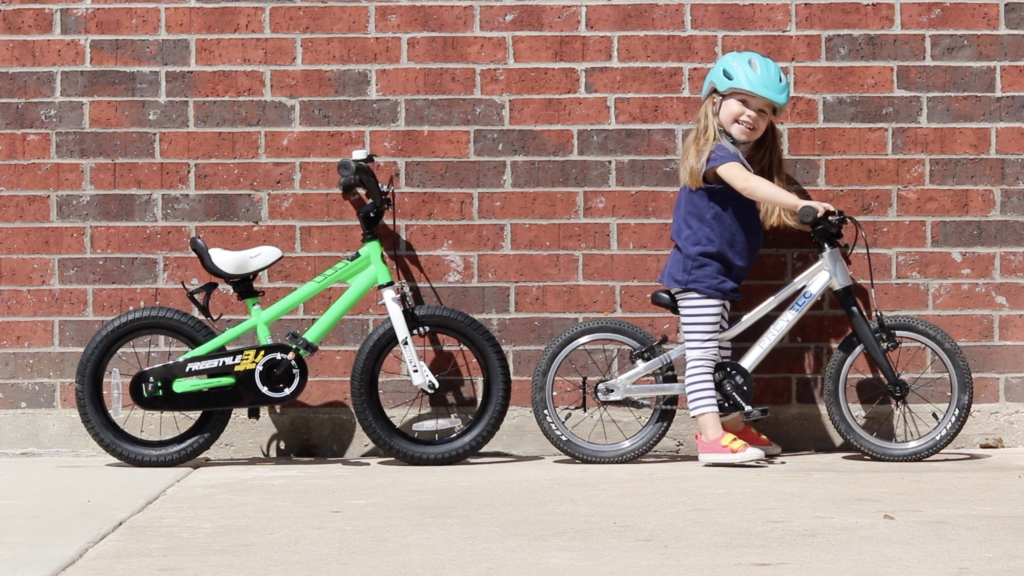
So instead of looking at the size of the bike’s wheels, it is best to look at the minimum and maximum seat height of the bike (provided in our mini-reviews above). When purchasing a bike for new riders, you ideally want the child’s inseam to match or be slightly under the minimum seat height of the bike (How to Measure a Child’s Inseam).
Why does the seat need to be set so low?
Having the ability to set the bike’s seat to a child’s inseam (or just below) is important for three reasons.
(1) It allows them to balance the bike while comfortably standing over it. Learning to ride a bike can be very intimidating, so eliminating nerves every step of the way is helpful.
(2) With the seat set lower than, or at, the child’s inseam, they will be able to easily stop the bike with their feet when they are nervous or forget to brake.

(3) It allows kids to get a running start before they start to pedal (kids run by putting their feet behind the pedals). A running start is key to helping new riders, especially balance bike graduates, learn to master pedaling. A bike in motion is much more stable than a stationary bike, so don’t teach your child to pedal from a stop (they naturally pick this up as they get older and more confident).

As time moves on and your brave 3-year-old masters pedaling, the seat height can be raised so that they are only touching the ground with their tiptoes. This allows for better leg extension while pedaling.
Geometry – A Common Problem with 12 Inch Bikes
The geometry of a bike refers to how the child is positioned on the bike. From frame design to handlebar shape, the geometry of a bike plays a huge role in how comfortable and easy it is to ride.
Unfortunately, due to the small size of 12 and 14 inch wheels, it can be very challenging for small bikes to have great geometry, especially on 12 inch bikes.
Small Wheels Lead to Cramped Pedal Stroke
The biggest problem lies in the fact that the center axle of 12 inch wheels are much closer to the ground than on larger 14 inch wheels. To make room for the crank arms and pedals on 12 inch bikes, the bottom bracket (where the crank arm attaches to the frame), has to be moved up on the bike.
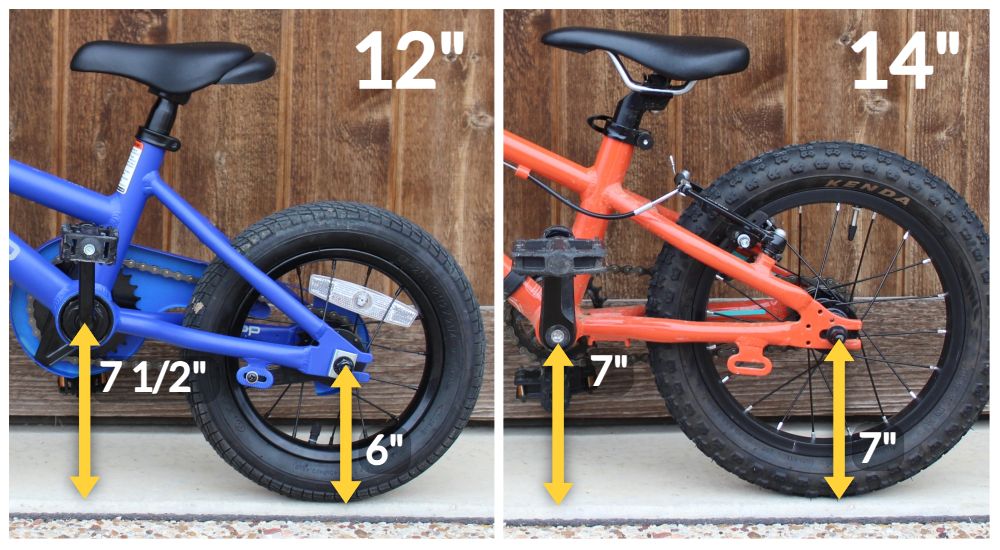
While this makes room for the pedals on the downswing, you lose over an inch of space on the upswing, creating a cramped leg position. With less space for the upswing, the child’s knees are at a much sharper and much less efficient angle to apply maximum force on the downswing (as shown on the blue bike below).

Moving up to 14 inch wheels makes a huge difference. As you can see above on the 14″ orange bike, the extra inch of space for the crank arms and bottom bracket allows for more space at the high stroke. The child’s knee is much less forward on the bike, making the downward pedal stroke significantly less angled and therefore much more efficient.
As a result, this is why almost all child-specific bike brands offer 14″ bikes versus 12″ bikes.
Higher Minimum Seat Height is Too Tall
To compensate for higher pedals on the upstroke, bike manufacturers often raise the minimum seat height of a 12″ bike, but that only causes more issues.
With a high minimum seat height, kids are often perched really high on top of the frame, which creates a high center of gravity on the bike and makes it harder to balance at lower speeds.
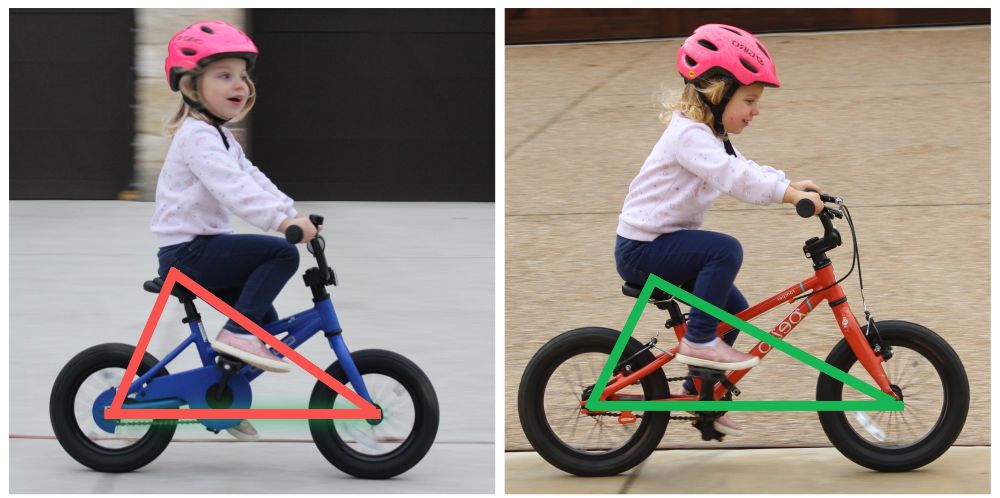
They also usually can’t touch the ground when sitting on the saddle, or if they can, it’s only with their tip toes. New riders need feet flat on the ground for confidence and safety.
Short Wheelbases Create a Cramped Ride
12 inch bikes also suffer from short wheelbases (the distance between the axles of the bike’s wheels). This causes kids to be scrunched on the bike, with little room between the handlebars and the seat.
Cockpit of Cheap 12″ vs. Well-Designed 14″ Bike
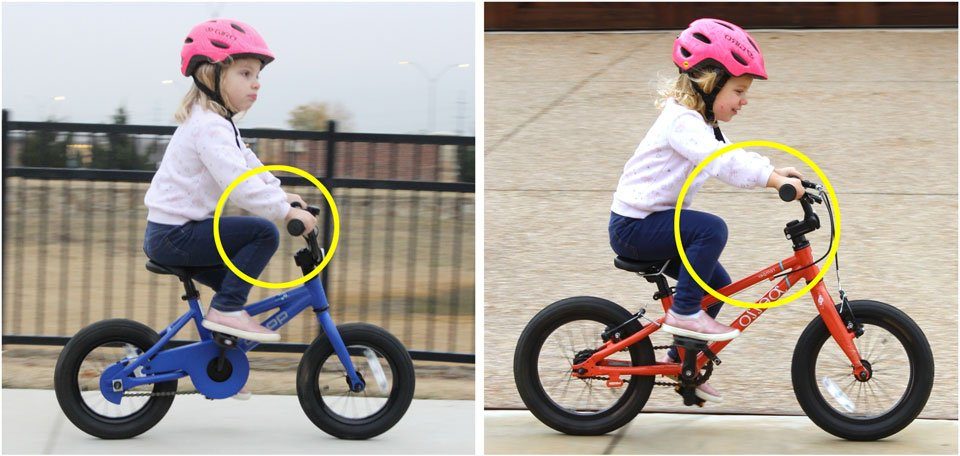
Short wheelbases negatively affect kids riding with or without training wheels in several ways.
- It prevents a child from being able to properly shift their weight around during a turn or even just to help them maintain balance.
- With the child sitting upright they are often not able to lean forward very much. As a result, there is less weight on the front tire, which makes the bike less stable and much more “squirrelly” when riding. This is especially problematic on bikes with lower-set handlebars like the blue bike shown above.
- On some bikes, turning can be a challenge as the handlebars can hit the child’s knees when turning.
The properly-designed 14 inch bikes we do recommend have longer wheelbases which provide more space for the child rider. This increases stability and maneuverability and makes the bikes easier to ride.
Weight – Lighter is better
Ideally, your child’s bike shouldn’t weigh more than 40% of their body weight. Learning to pedal and balance at the same time can be challenging, but even more so if your child has to work extra hard to keep a heavy bike upright. Getting up from a fall is also far more discouraging when your bike weighs a ton!
For example, the Royal Baby 14″ bike weighs 21.7 lbs, while the woom 2 (14 inch) only weighs 12.3 lbs. That’s almost TEN extra pounds of bike! Which bike do you think will be easier for your 3-year-old to maneuver?
Brakes – Try to avoid coaster brakes
Coaster brakes (back pedal brakes) are required by CPSC standards on almost all kids 12 inch and 14 inch bikes in the US, but they can make it much more difficult to learn to pedal while balancing a bike.
Because a child naturally pedals backward (especially when learning to pedal), coaster brakes become problematic as they cause kids to brake accidentally, which can lead to falls and lost motivation. Even once they have mastered balancing, preventing the child’s natural inclination to pedal backward to regain balance puts the child at a disadvantage.
If a child is coordinated enough to be riding a bike without training wheels, they are most likely also coordinated enough to use a hand brake. Also, keep in mind that the hand brakes on higher-end kids’ bikes today are significantly easier to use than the hand brakes you had on your bike as a kid. The brake levers on these bikes are easy for small hands to reach and require minimal effort for them to pull.
Due to CPSC regulations, many higher-end 14 inch bikes are still sold with a coaster brake, but these companies also offer an optional “freewheel kit” that allows you to swap out the back wheel and remove the coaster brake on your own. These bikes are then coaster-brake-free and rely on much better handbrake system to stop the bike.
Using Training Wheels with Small Bikes
While we can attest to the benefits of balance bikes over training wheels, we understand that sometimes families prefer to use training wheels. If you do decide to use training wheels, be sure to buy a bike that has stable and secure training wheels.
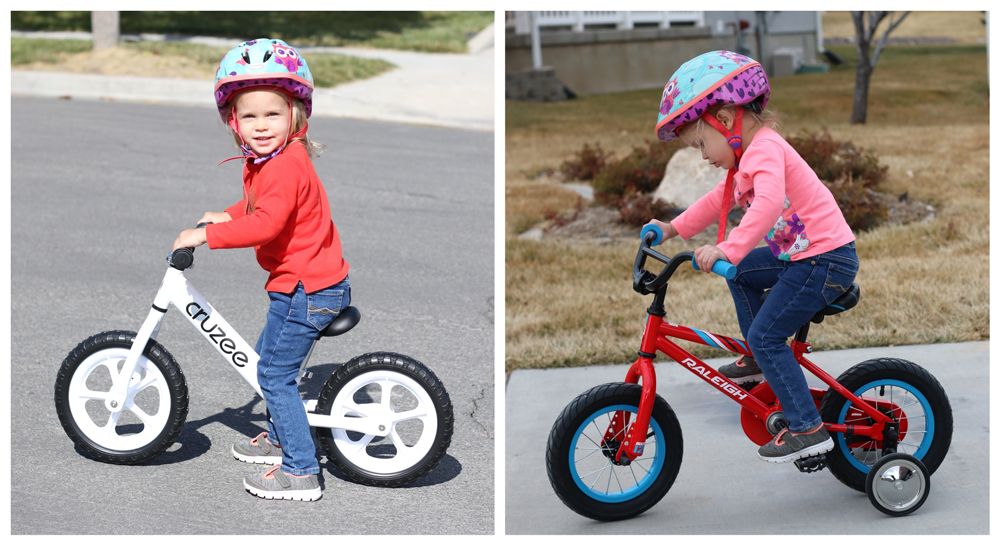
Also, once your child is ready to take the training wheel off, try using their bike as a balance bike to help ease the transition. To do so, remove the training wheels and pedals and have the child practice running while seated on the bike.

Once they can run and glide on the bike, put the pedals back on and add pedaling at the third step. First run on the bike, then glide, and lastly start pedaling. For a more thorough explanation of how this works, read our article How To Teach a Kid to Ride a Bike the Easy Way.
Why trust us?
We have thoroughly tested every bicycle on this list and have a garage storage problem to prove it! Unlike other websites, we don’t just build lists, we actually test each product with our own kids. With 15 years of bike testing under our belt, we’ve personally met and consulted with many top brands in the industry including woom, Guardian, Strider, Prevelo and Cleary.
Related Kids Bikes Articles
10 Best Girl Bikes: Looking for a high-performance bike in pink, purple, or cute designs? Check out our list!
Training Wheels: 10 Frequently Asked Questions: Training wheels make learning to ride a bike harder. Find out why!
